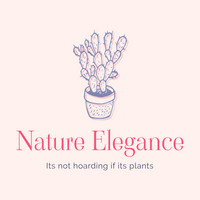Decoding Plant Leaves: A Comprehensive Guide
- Nature Elegance
- Oct 1
- 4 min read
Understanding your plants begins with an attention to their most visible and telling feature: their leaves. Leaves can tell you a lot about the overall health of your indoor and outdoor plants. By observing their colors, shapes, spots, and textures, you can decode the messages they communicate. In this guide, we will delve into the significance of various leaf characteristics and offer practical tips for diagnosing issues and ensuring your plants continue to thrive.
Why Leaf Observation Matters
Leaf health is a strong indicator of plant vitality. Leaves are the primary site of photosynthesis, absorbing sunlight and converting it into energy. Healthy leaves also play a critical role in transpiration, which affects a plant's water regulation. By regularly observing your plants’ leaves, you can spot early signs of stress, pest infestations, or diseases before they escalate. This proactive approach allows you to take corrective actions promptly, maintaining the aesthetic and health of your plants.

Analyzing Leaf Colors
Leaf discoloration is often the first sign of trouble. Healthy leaves are typically vibrant green, but various shades and tones can indicate specific issues:
Yellow Leaves: Often a sign of overwatering or nitrogen deficiency. If leaves turn yellow while the soil is wet, it’s crucial to reduce watering frequency.
Brown Edges: This can be due to underwatering, high temperatures, or low humidity. Ensure your plant is getting adequate moisture and consider using a humidifier if needed.
Red-Purple Hues: These colors may indicate phosphorus deficiency, particularly in cooler temperatures. If your plant is displaying these hues, check the soil nutrients, especially if it is a young plant.

Understanding Leaf Shapes
The shape of leaves can also hint at specific health issues or environmental adaptations:
Small or Stunted Leaves: This can indicate inadequate light or poor soil conditions. Consider relocating your plant to a sunnier spot or enriching its soil with organic matter.
Curled Leaves: Curling can be a response to stress, possibly due to pest activity or environmental factors. Investigate the plant and its surroundings to identify the cause.
Brown Spots: Often a sign of fungal infections. If you notice these spots, isolate the plant from others and consider using a fungicide.
Leaf Textures: What They Reveal
The texture of leaves can be just as telling as color and shape. Here are some common texture-related issues:
Wilting Leaves: Leaves that feel soft and are drooping may indicate underwatering. If this persists, the plant could be at risk of wilting seriously.
Crinkly or Rigid Leaves: This can indicate a loss of moisture, possibly due to low humidity or pest stress. Consider misting the leaves or moving the plant to a more humid environment.
Sticky Residue: A sign of aphids or scale insects. If your leaves are sticky, investigate the undersides for any pests. Controlling pests promptly is essential to keep your houseplants protected.
Diagnosing Common Issues
Now that we have reviewed key characteristics to look for in leaves, let’s discuss how to diagnose common plant issues based on these observations:
Inspect Regularly: Shield your plants from potential dangers by observing them closely, at least once a week. Look under the leaves too.
Check Soil Conditions: Healthy soil is paramount. If you consistently notice leaf issues, test the soil's moisture and nutrient levels. Poor drainage can also cause root rot.
Monitor Environmental Conditions: Be aware of how seasons and indoor climate impact leaf health. Plants may require more frequent watering in summer due to higher temperatures.
Use Natural Remedies: For pest problems, consider introducing natural predators (like ladybugs) or using neem oil as a safer pesticide option.

Responding to Leaf Stress, Pests, and Disease
Understanding your plant’s needs is crucial in maintaining health. Here’s some advice on how to respond effectively:
For plants with yellow leaves, reduce watering, and ensure they are getting adequate nutrients. A diluted, balanced fertilizer can work wonders.
If you observe red or purple leaves, assess your soil’s pH and nutrient levels. Adding phosphorus can help if deficiencies are confirmed.
Wilting or drooping leaves require immediate attention. Reassess your watering schedule and consider relocating the plant if it lacks sunlight.
For pests, use insecticidal soap or a mixture of water and mild dish soap. Always test a small area first to avoid stress.
The Ongoing Process of Leaf Care
Caring for your plants is an ongoing process, and regular leaf observations will yield the best outcomes. The more familiar you become with your plants, the easier it will be to spot changes that may suggest a solution. Make it a habit to take notes about your observations. Tracking changes can provide useful insights when seeking to improve plant care practices.
Adopting a Holistic plant Care Approach
Paying attention to your plants’ needs encompasses more than just leaves. Here are some holistic methods to consider:
Create a Caring Environment: Understand the specific needs of your plants, including their light, water, and humidity requirements.
Educate Yourself: Stay informed about the specific types of plants you have, as each species has unique leaf characteristics that require attention.
Be Patient: Plants take time to respond to care adjustments. Maintain a consistent routine and be patient with their progress.
Keep Thriving with Observational Skills
Ultimately, decoding plant leaves boils down to observation and responsiveness. With practice, you’ll develop an intuitive understanding of what your plants are signaling through their leaves. Remember, well-cared-for plants show fewer stresses, leading to a more vibrant home. Use your newfound skills to cultivate not only a garden of plants but also a living collection of beauty that enriches your life.
As you embark on your journey to becoming a keen observer, you'll realize that the intricacies of plant leaves tell a compelling story about their lives, vitality, and the care you provide. Whether you are nurturing your first houseplant or managing an entire garden, these decoding skills will support your goals, letting you watch your plants thrive beautifully.




Comments